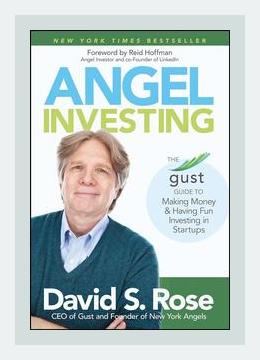Entrepreneurship and StartupsFunding and Investment
**
David S. Rose’s “Angel Investing: The Gust Guide to Making Money and Having Fun Investing in Startups” is an insightful guide tailored for existing and aspiring angel investors. Rose is a seasoned entrepreneur and angel investor, providing practical advice reinforced with real-world examples. This comprehensive book delves into the intricate process of angel investing, from identifying high-potential startups to executing successful investment exits. This summary encapsulates the most salient points in a structured manner, highlighting actionable steps for prospective angel investors.
1. Understanding Angel Investing
Main Point: Angel investing is a specialized form of equity financing provided by affluent individuals to early-stage startups. Unlike venture capitalists, angel investors use their own money, directly impacting startups in their nascent stages.
Example: Rose recounts his experience investing in companies like JUMP Bikes and how early-stage funding enabled the company to scale before being acquired by Uber.
Actionable Step: Conduct thorough research on angel investing market trends and familiarize yourself with successful case studies and failures to understand the dynamics involved.
2. Attributes of a Successful Angel Investor
Main Point: Successful angel investors possess a combination of financial acumen, patience, diligence, and an appetite for risk. More importantly, they provide strategic value beyond capital.
Example: Rose illustrates the story of Idealab’s founder Bill Gross, who not only invested but also provided critical mentorship that significantly shaped the success of numerous startups.
Actionable Step: Evaluate your personal traits, financial situation, and willingness to commit beyond capital investment. Consider participating in angel investor groups or associations to refine your skills.
3. Building a Solid Investment Strategy
Main Point: Developing a well-defined strategy is pivotal. This includes deciding on investment focus areas, understanding the amount of capital you are willing to risk, and defining clear criteria for startup evaluation.
Example: Rose’s strategy includes diversifying his investments across a range of industries and stages, thereby balancing potential risks and returns.
Actionable Step: Draft a detailed investment thesis outlining your areas of interest, risk tolerance, and diversification plan. Regularly revisit and adjust the thesis based on market developments and personal financial insights.
4. Navigating the Due Diligence Process
Main Point: Conducting meticulous due diligence is critical for identifying viable investment opportunities and mitigating risks. This involves analyzing the startup’s team, market, product, and financials.
Example: Rose shares the story of how intensive due diligence led to his investment in Zipcar, highlighting how understanding the management team’s competence and market potential led to a successful exit.
Actionable Step: Create a structured due diligence checklist covering essential areas like team background, market size, competitive landscape, financial projections, and legal considerations.
5. Assessing the Founding Team
Main Point: The founding team’s capabilities, experience, and alignment with the investor’s values are pivotal. The right team can pivot and navigate challenges effectively.
Example: Rose discusses his investment in Chain.com where the founder’s deep domain expertise and passion convinced him of their potential despite early-stage uncertainties.
Actionable Step: Conduct detailed interviews and background checks on the founding team. Seek references from trusted sources and evaluate team dynamics and leadership qualities.
6. Valuation and Deal Structuring
Main Point: Valuation and deal structuring discussions are crucial in balancing interests between investors and founders. Both equity valuation and convertible notes are commonly used structures.
Example: Rose recalls negotiating a fair valuation for the startup FundingPost, which involved balancing the founders’ optimism with realistic future financial projections.
Actionable Step: Study different valuation methods and negotiate terms that safeguard your interests while ensuring founders are motivated. Consider legal advice to draft comprehensive term sheets.
7. Adding Value Beyond Capital
Main Point: Beyond financial investment, angel investors often provide mentorship, resources, and strategic connections, significantly amplifying a startup’s chances of success.
Example: Rose describes his advisory role in the startup StageIt, where his network helped the company secure crucial industry partnerships.
Actionable Step: Leverage your expertise, network, and resources to support startups post-investment. Establish regular touchpoints to offer strategic guidance and monitor progress.
8. Managing Risk and Building a Portfolio
Main Point: Diversification is essential in managing the inherent risks of angel investing. A broad portfolio increases the likelihood of achieving high returns despite individual startup failures.
Example: Rose outlines his experience of maintaining a diversified portfolio with investments across various sectors including tech, healthcare, and green energy, which mitigated risks.
Actionable Step: Spread your investments across at least 20-30 startups over time to balance the risk profile. Aim to invest in different industries and stages to diversify effectively.
9. The Exit Strategy
Main Point: An exit strategy is paramount as it determines the return on investment. Common exit routes include acquisitions, IPOs, and secondary market sales.
Example: Rose shares his observation on the successful exit from JUMP Bikes upon its acquisition by Uber, which exemplified high returns due to strategic timing and market readiness.
Actionable Step: Discuss and align on potential exit scenarios with startup founders early in the investment process. Regularly review the startup’s progress to adapt exit strategies as required.
10. Legal and Tax Considerations
Main Point: Understanding legal and tax implications is critical to maximize returns and comply with regulatory requirements. This includes equity agreements, intellectual property rights, and tax benefits related to angel investing.
Example: Rose references the importance of 83(b) elections for investors in minimizing tax liabilities and optimizing investment outcomes.
Actionable Step: Engage with a legal advisor to navigate equity contracts and potential tax benefits in your jurisdiction. Ensure comprehensive legal documentation and compliance.
Conclusion
David S. Rose’s “Angel Investing: The Gust Guide to Making Money and Having Fun Investing in Startups” offers a comprehensive playbook for navigating the complex landscape of angel investing. By emphasizing thorough research, strategic planning, and active engagement, Rose provides a road map for success in this high-risk, high-reward domain. The actionable steps derived from each major point foster practical application, empowering investors to not just make money, but also have fun in the dynamic world of startups.
